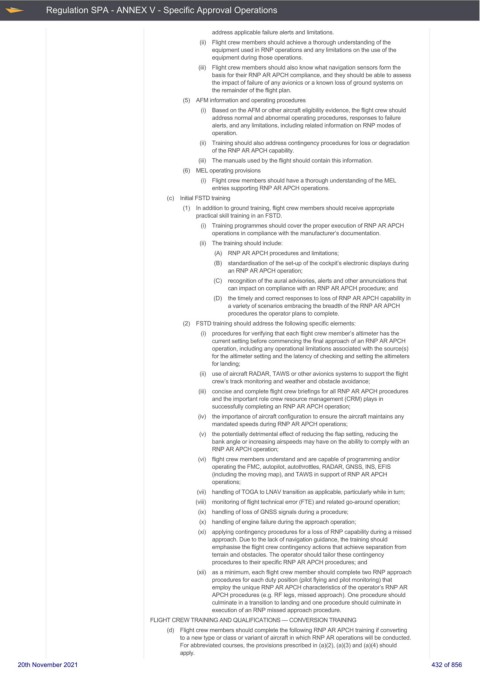Page 432 - UK Air Operations Regulations 201121
P. 432
~
~ Regulation SPA - ANNEX V - Specific Approval Operations Centrik
address applicable failure alerts and limitations.
(ii) Flight crew members should achieve a thorough understanding of the
equipment used in RNP operations and any limitations on the use of the
equipment during those operations.
(iii) Flight crew members should also know what navigation sensors form the
basis for their RNP AR APCH compliance, and they should be able to assess
the impact of failure of any avionics or a known loss of ground systems on
the remainder of the flight plan.
(5) AFM information and operating procedures
(i) Based on the AFM or other aircraft eligibility evidence, the flight crew should
address normal and abnormal operating procedures, responses to failure
alerts, and any limitations, including related information on RNP modes of
operation.
(ii) Training should also address contingency procedures for loss or degradation
of the RNP AR APCH capability.
(iii) The manuals used by the flight should contain this information.
(6) MEL operating provisions
(i) Flight crew members should have a thorough understanding of the MEL
entries supporting RNP AR APCH operations.
(c) Initial FSTD training
(1) In addition to ground training, flight crew members should receive appropriate
practical skill training in an FSTD.
(i) Training programmes should cover the proper execution of RNP AR APCH
operations in compliance with the manufacturer’s documentation.
(ii) The training should include:
(A) RNP AR APCH procedures and limitations;
(B) standardisation of the set-up of the cockpit’s electronic displays during
an RNP AR APCH operation;
(C) recognition of the aural advisories, alerts and other annunciations that
can impact on compliance with an RNP AR APCH procedure; and
(D) the timely and correct responses to loss of RNP AR APCH capability in
a variety of scenarios embracing the breadth of the RNP AR APCH
procedures the operator plans to complete.
(2) FSTD training should address the following specific elements:
(i) procedures for verifying that each flight crew member’s altimeter has the
current setting before commencing the final approach of an RNP AR APCH
operation, including any operational limitations associated with the source(s)
for the altimeter setting and the latency of checking and setting the altimeters
for landing;
(ii) use of aircraft RADAR, TAWS or other avionics systems to support the flight
crew’s track monitoring and weather and obstacle avoidance;
(iii) concise and complete flight crew briefings for all RNP AR APCH procedures
and the important role crew resource management (CRM) plays in
successfully completing an RNP AR APCH operation;
(iv) the importance of aircraft configuration to ensure the aircraft maintains any
mandated speeds during RNP AR APCH operations;
(v) the potentially detrimental effect of reducing the flap setting, reducing the
bank angle or increasing airspeeds may have on the ability to comply with an
RNP AR APCH operation;
(vi) flight crew members understand and are capable of programming and/or
operating the FMC, autopilot, autothrottles, RADAR, GNSS, INS, EFIS
(including the moving map), and TAWS in support of RNP AR APCH
operations;
(vii) handling of TOGA to LNAV transition as applicable, particularly while in turn;
(viii) monitoring of flight technical error (FTE) and related go-around operation;
(ix) handling of loss of GNSS signals during a procedure;
(x) handling of engine failure during the approach operation;
(xi) applying contingency procedures for a loss of RNP capability during a missed
approach. Due to the lack of navigation guidance, the training should
emphasise the flight crew contingency actions that achieve separation from
terrain and obstacles. The operator should tailor these contingency
procedures to their specific RNP AR APCH procedures; and
(xii) as a minimum, each flight crew member should complete two RNP approach
procedures for each duty position (pilot flying and pilot monitoring) that
employ the unique RNP AR APCH characteristics of the operator’s RNP AR
APCH procedures (e.g. RF legs, missed approach). One procedure should
culminate in a transition to landing and one procedure should culminate in
execution of an RNP missed approach procedure.
FLIGHT CREW TRAINING AND QUALIFICATIONS — CONVERSION TRAINING
(d) Flight crew members should complete the following RNP AR APCH training if converting
to a new type or class or variant of aircraft in which RNP AR operations will be conducted.
For abbreviated courses, the provisions prescribed in (a)(2), (a)(3) and (a)(4) should
apply.
20th November 2021 432 of 856

